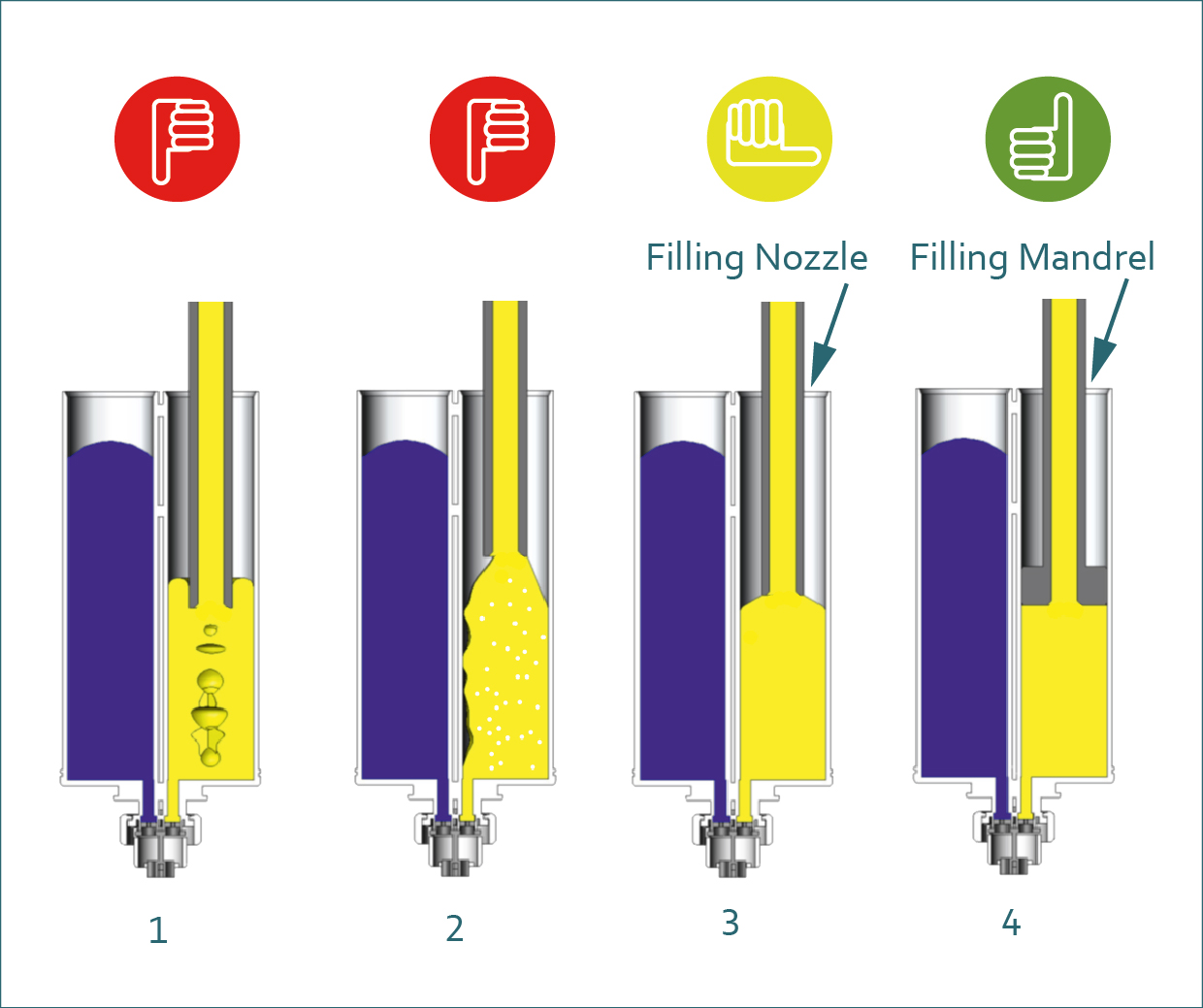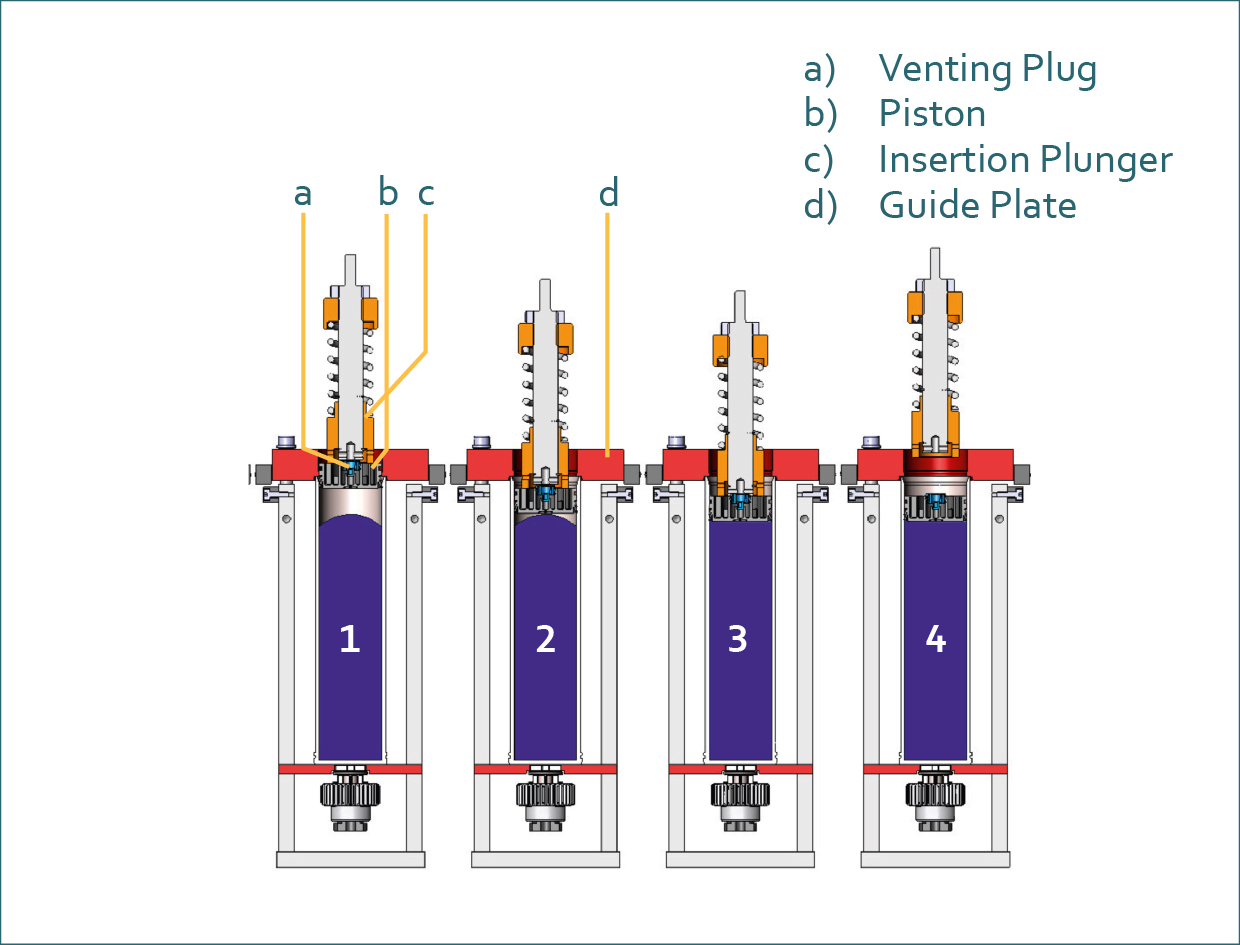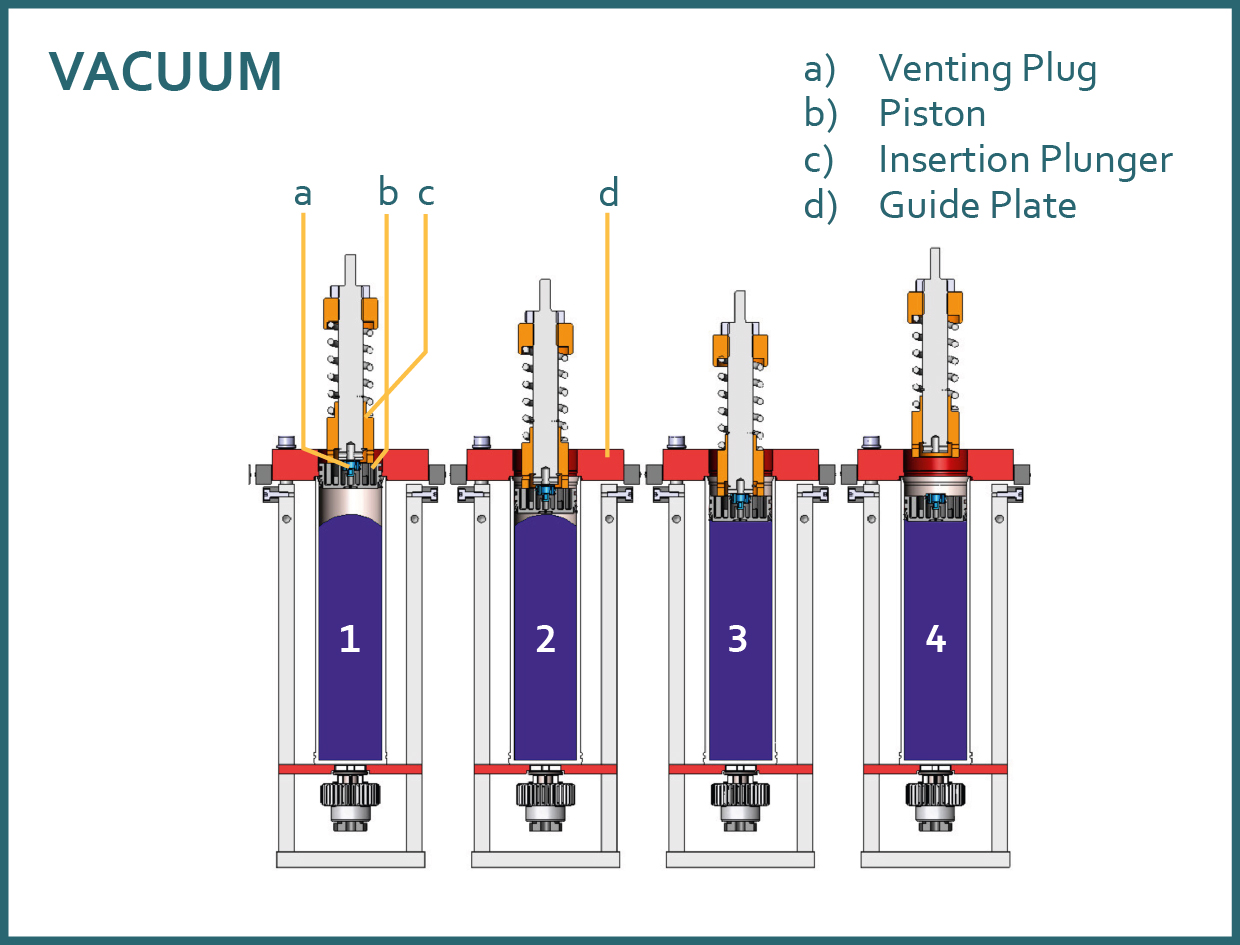Air-Free Filling and Storage of Cartridges (Airfreeness)
Advancing Mixing Quality by Air Free Filling and Storage of Cartridges
PRODUCT RELATED TECHNOLOGIES – Adhesive bonding processes can be severely compromised by the presence of air inclusions in the bead and by air-induced system elasticities during stop-and-go operations. Ensuring that a cartridge is filled in an air-free manner, and remains air-free during storage, is essential to avoid these effects. The optimization of maintaining long-term high-quality material, even when stored for extended periods, begins with the correct filling process and piston setting for storage and transportation.
Air-Free Filling and Piston Setting
Achieving high-quality filling is contingent on the bulk adhesive being air-free from the outset. This can be accomplished, for instance, through evacuation steps. As depicted in the graphic below, filling from the back involves precise filling mandrel geometry and synchronized movements to ensure an air-free process. For back-filling applications, utilizing extended front caps, which effectively fill the narrow outlet channels, helps prevent air from remaining in the cartridge outlet.
 Figure 1: Airfree Filling
Figure 1: Airfree Filling
Image description:
- Filling nozzle moving too slow
- Filling nozzle moving too fast
- Filling nozzle movement synchronized with fill level
- Filling mandrel, shielding adhesive from the atmosphere, for optimal results.
Front-filling of cartridges, though less common, typically involves longer cycle times compared to back-filling. This method can be advantageous as it prevents the adhesive from being exposed to the atmosphere of the filling facility. The small gap between the piston and the cartridge bottom can be a source of air entrapment, often localized at the piston after filling. Achieving air-free conditions necessitates a vacuum step at the beginning of the process.
Collapsible cartridges, usually comprising foldable foil sleeves, may necessitate front-filling, including a vacuuming step at the start. Once filled under air-free conditions, these cartridges offer the significant advantage of remaining air-free. They are hermetically sealed, and the flexibility of the foil counteracts the issues described later in this article.
Piston setting is a delicate process, as the sealing lips can be easily damaged, especially when using solid pistons in combination with shims. This process requires precise control to close the venting holes on the piston at the right moment. It's crucial that no air remains inside the cartridge, while at the same time ensuring that material does not overflow through the piston venting. More advanced piston designs than solid pistons are available to improve this setting process. These include pistons with venting mechanisms and self-venting features, which minimize air entrapment and simplify the process.
 Figure 2: Piston Insertion
Figure 2: Piston Insertion
- The piston is sitting in the Guide Plate, ready for insertion
- The piston is pushed down toward the adhesive by the Insertion Plunger while air is venting through the piston
- The piston is in close contact with the adhesive and the piston stops moving. The spring mechanism closes the Venting Plug
- Once the Insertion Plunger is returned to the initial position, the cartridge is ready for storage
The standard piston setting process achieves good fill quality, sufficient for most industrial and dental applications. However, for more demanding applications, such as the automated assembly process of electronic devices, implementing piston setting (and closing) in a vacuum can significantly reduce air inclusions at the piston, potentially by orders of magnitude. The vacuum inclusions will collapse once the cartridges are returned to ambient pressure.
 Figure 3: Piston Insertion in Vacuum
Figure 3: Piston Insertion in Vacuum
A vacuum chamber is added to the piston setting process.
- The piston is sitting in the Guide Plate, ready for insertion. The vacuum system is activated.
- The piston is pushed down toward the adhesive by the Insertion Plunger while a low-pressure atmosphere is venting through the piston
- The piston in close contact with the adhesive and the piston stops moving. The spring mechanism closes the Venting Plug
- Once the Insertion Plunger is returned to the initial position and atmospheric pressure is restored in the chamber, the cartridge is ready for storage
Air-Free Storage and Transportation
Pressure and temperature fluctuations during storage, along with possible vibrations, can create conditions where air may enter the cartridge through the piston's sealing lips. The underlying mechanisms involve the formation of a vacuum inside the cartridge, which is gradually replaced by air. The vacuum in a cartridge can be caused by the following mechanisms:
- Low-temperature conditions can lead to the thermal shrinkage of adhesives. As the adhesives contract, the piston remains in its initial position, leading to the formation of a vacuum.
- High-temperature conditions may cause the thermal expansion of the adhesive, pushing the piston backward. When the temperature returns to normal, the piston stays in this new position, resulting in a cartridge pressure below ambient.
- In a low-pressure environment, for example during airfreight, any existing air bubble or elastic fillers inside the cartridge may expand, pushing the piston backward. The piston remains in this new position, leaving the cartridge pressure below ambient.
- Vibrations or shocks have the potential to move the piston backward, consequently leaving the cartridge under low-pressure conditions.
The piston sealings in cartridge systems are designed to be tight, ensuring sufficient barrier properties for shelf life and maintaining tightness during application. However, these piston sealings create a considerable amount of friction during dispensing, which reduces dispensing performance and speed. To keep friction losses at an acceptable level, constraints must be placed on the number of sealing lips, O-rings, and their contact pressures. As a result, over extended periods, air may gradually infiltrate the system.
Possible Solutions to the Problem
Standard cartridges are widely available, and custom-designed solutions may not always be cost-effective. Depending on the underlying cause of air entrapments, the following approaches could help minimize the amount of air in standard cartridges:
- The adhesive filling temperature and storage temperature should be the same.
- Temperature fluctuations during storage should be avoided.
- If temperature changes are unavoidable (such as filling at heated conditions and refrigerated storage), applying force to the pistons during the cool-down phase can compensate for the thermal shrinkage of the adhesive.
- The sensitivity to ambient pressure fluctuations can be reduced by using incompressible adhesives and ensuring high-quality fills from the beginning (e.g., piston setting in a vacuum).
While process adaptations can help prevent air inclusions, some changes may be challenging to implement or might affect profitability. Conducting a risk analysis should be the first step in any cost-benefit evaluation. For instance, an existing air inclusion located right at the piston, due to gravity or viscosity, will have a very low probability of escaping through the mixing tip.
The author: Carsten Degendorfer
Dr. Carsten Degendorfer has been employed at medmix Switzerland AG since 2019 and leads the Application Laboratory. His responsibilities include defining specifications and validation tests for product developments. The development of new measurement methods for technology development, as well as providing conditions for numerical simulations, are among his areas of expertise, just like technology consulting for customer inquiries.